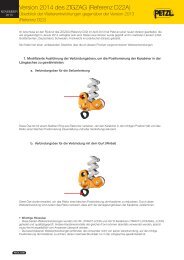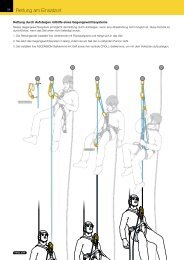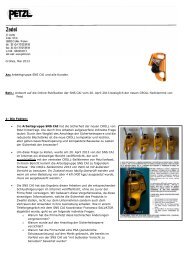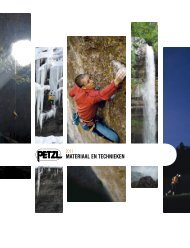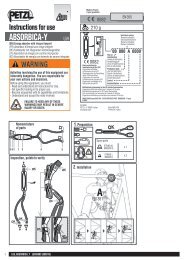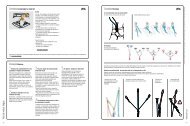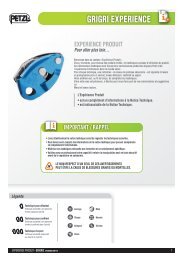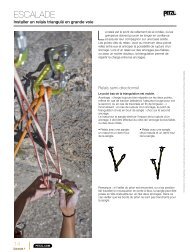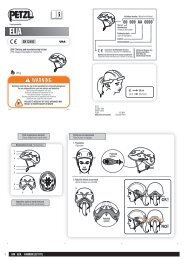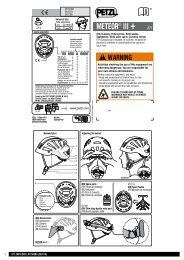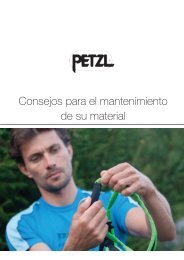Create successful ePaper yourself
Turn your PDF publications into a flip-book with our unique Google optimized e-Paper software.
PETZL YESTERDAY, TODAY AND TOMORROW<br />
1956<br />
Fernand <strong>Petzl</strong>, -1122 m<br />
Berger Cavern (France)<br />
1968<br />
The first rope ascenders and<br />
descenders (BASIC, SIMPLE) are<br />
brought to market.<br />
1977<br />
The first <strong>Petzl</strong> harnesses are<br />
produced.<br />
1981<br />
The ZOOM headlamp is introduced.<br />
1986<br />
The test tower is established.<br />
1991<br />
The GRIGRI, the first self-braking belay<br />
device, is invented.<br />
2000<br />
The TIKKA, the first compact LED<br />
headlamp, is launched.<br />
2002<br />
The QUARK ERGO, the first leashless<br />
ice axe with angled grip, gives new<br />
freedom to ice climbing techniques.<br />
2006<br />
<strong>Petzl</strong> Foundation is created.<br />
2008<br />
V.axess, <strong>Petzl</strong>'s training and<br />
experimentation center, is created.<br />
2011<br />
Paul <strong>Petzl</strong> receives the trophy for<br />
"Outdoor Celebrity 2011".<br />
4<br />
Contents<br />
Fernand <strong>Petzl</strong>, the story of a pioneer<br />
In the early 1930s, Fernand <strong>Petzl</strong><br />
discovered caving at the age of<br />
seventeen. A mechanic by trade,<br />
he quickly began envisioning<br />
new techniques for caving, which<br />
was still a rudimentary discipline<br />
at the time. In his workshop after<br />
work, he began hand-producing<br />
products and systems for himself<br />
and his caving friends. His<br />
goal: to conquer, on the following<br />
Sunday,underground obstacles in<br />
previously inaccessible galleries.<br />
He invented and perfected new and innovative products in the 1940s<br />
with his friend, Pierre Chevalier. Their collaboration was a turning point.<br />
Together they explored the initial seventeen kilometers of underground<br />
galleries of the Dent de Crolles and established a new world record<br />
for exploration below 600 meters. Significantly, they perfected new<br />
techniques for progression by pioneering the use of nylon ropes instead<br />
of the fixed ladders that were in use at the time.<br />
In the 1950s, Fernand <strong>Petzl</strong> led an international expedition to the Berger<br />
Cavern in the Vercors region of France. A new record of -1122 meters<br />
was set and Fernand <strong>Petzl</strong> became part of the history and the legend of<br />
caving. This did not prevent him from continuing to improve the ascender,<br />
then the descender in the ‘70s, eventually allowing ropes to completely<br />
replace ladders. These innovations would soon find their place in sport,<br />
rescue and later in industry and construction.<br />
In 1968, Fernand <strong>Petzl</strong> mass production of his ascenders in his own<br />
workshop. Then in 1970, with his sons Pierre and Paul, he expanded<br />
his production to include mountaineering gear as well. After inventing<br />
lighting for caving, the team created the first headlamp designed for<br />
mountaineers. This was the beginning of the adventure for the <strong>Petzl</strong><br />
brand.



